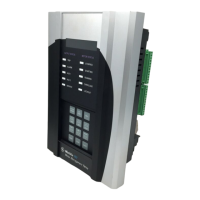CGCOMMUNICATIONS GUIDE PROFIBUS-DPV1 COMMUNICATIONS
369 MOTOR MANAGEMENT RELAY – COMMUNICATIONS GUIDE CG17
3.2 369 Relay Profibus Configuration
The Profibus-DPV1 basic configuration has one DP/V1 master and one DPV1 slave. In a
typical bus segment up to 32 stations can be connected (a repeater has to be used if more
then 32 stations operate on a bus). The end nodes on a Profibus-DPV1 network must be
terminated to avoid reflections on the bus line.
The bus address for the relay as Profibus-DPV1 node can be set using the
S1 369 SETUP
ÖØ 369 COMMUNICATIONS ÖØ PROFIBUS ADDRESS setpoint or via the EnerVista 369
Setup software, which extends address range from 1 to 126. Address 126 is used only for
commissioning purposes and should not be used to exchange user data.
The Profibus media is a twisted-pair copper cable along with 9-pin Sub-D connector, which
connects the bus to the 369 Relay socket on the back of the relay. The 369 Motor
Management Relay has autobaud support. The baud rates and other slave specific
information needed for configuration are contained in the 369_09E6.gse file, which is used
by a network configuration program.
The 369 Motor Management Relay as a DPV1 slave transfers fast process data to the DP/
V1 master according to master-slave principle. The 369 Relay is a modular device,
supporting up to 111 input modules.
Modules define a block size of input data to be read by the master, starting from offset
zero. Adding modules in your Master configuration increases the size of the total block of
data that the Master will read, making it easy to choose a total block size of data that
matches the user's requirements.
3.3 369 Relay Profibus Input Data
There are two options for configuring what data is made available through Profibus Input
Data, based on the value of the
PROFIBUS CYCLIC IN DATA setpoint (see 369 Instruction
Manual, chapter 5 for details). If the
PROFIBUS CYCLIC IN DATA setpoint is set to “0” (default
map), then the data available to be read matches Table CG–1: Profibus Input Data on page
CG–6.
The user can also exactly define the data provided and the order of that data. The Modbus
User Definable Memory Map area and the
PROFIBUS CYCLIC IN DATA setpoint are used to
define this data. The
PROFIBUS CYCLIC IN DATA setpoint determines the number of 16-bit
registers available to be read through Profibus Input Data and the Modbus User Definable
Memory Map is used to determine the data provided and the order of the data.
For example, if the user only wishes to read two 16-bit registers of data (4 bytes), the user
selects a number of Input Modules from the GSD file that add up to a total of 4 bytes. When
the Profibus Master is reading the Input data, only 4 bytes of Input data will be sent in the
communication packet. The number of words should match the
PROFIBUS CYCLIC IN DATA
setpoint, but it's not necessary. If the number of Input data bytes read from the master is
greater than the user has defined with the
PROFIBUS CYCLIC IN DATA setpoint, the balance
of the data will return zero values.

